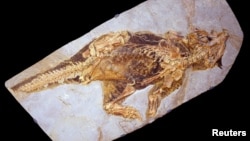Scientists guided by small structures preserved in fossilized skin have deciphered the color and camouflage pattern of a little dinosaur with a parrot-like beak and bristles on its tail that roamed thick forests in China about 120 million years ago.
Psittacosaurus was mainly brown but with a paler underside of the tail and belly, a pattern called countershading that may have helped the 5-foot-long (1.5-meter) bipedal plant-eater go unnoticed by hungry predators, the scientists said on Thursday.
It also had a heavily pigmented face and hind legs that were striped on the inside and reticulated and spotted on the outside.
The color pattern suggested Psittacosaurus (pronounced sit-TAK-ah-sawr-us) lived in a forest environment with diffuse light from a dense canopy of trees, the researchers said. They created a life-sized, full-color, three-dimensional model based on their findings.
"Our model suggests it was super, super cute. I think they would have made fantastic pets. They look a bit like E.T.," said molecular paleobiologist Jakob Vinther of the University of Bristol in Britain, referring to the friendly alien in the 1982 film "E.T. the Extra-Terrestrial."
Psittacosaurus, meaning "parrot lizard," is one of the most thoroughly studied dinosaurs, with hundreds of individual fossils. It was roughly the size of a Labrador retriever, and probably was a common meal for Cretaceous Period predators like the 30-foot-long (9 meters) T. rex cousin Yutyrannus.
"It was eaten by a lot of other animals," Vinther said, and must have quickly evolved optimal color patterns for camouflage.
Psittacosaurus is the third dinosaur to have its color deduced using fossilized organelles called melanosomes that synthesize and store the pigment melanin in vertebrate animals and are present in hair, feathers and skin. It also was the first time researchers were able to hypothesize the environment a dinosaur inhabited based on its coloration.
Psittacosaurus, an early member of the horned-dinosaur group that includes the massive Triceratops, had a short face and a strong beak to eat plants, and boasted bristly long filaments above the tail.
Countershading is a pattern that serves to conceal shadows on an animal, making it appear more flat optically and less conspicuous, Vinther said.
"It is everywhere. We see it in the sea, on land and in flying birds," Vinther said. "Examples could be penguins, puffins, dolphins, mackerel, deer, foxes, antelopes. You name it. It's ubiquitous."
The research was published in the journal Current Biology.
Scientists Decipher Color of 'Super Cute' Bristly Dinosaur
- By Reuters










